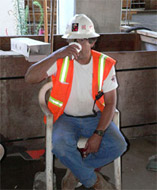 Heat Illness Prevention
Heat Illness Prevention 
Sufficient Amounts of Drinking Water
Elements of Your Written Program and Effective Work Practices
What is in T8CCR 3395?
T8CCR 3395(c) states the following:
- Provision of water. Employees shall have access to potable drinking water meeting the requirements of Sections 1524, 3363, and 3457, as applicable, including but not limited to the requirements that it be fresh, pure, suitably cool, and provided to employees free of charge. The water shall be located as close as practicable to the areas where employees are working. Where drinking water is not plumbed or otherwise continuously supplied, it shall be provided in sufficient quantity at the beginning of the work shift to provide one quart per employee per hour for drinking for the entire shift. Employers may begin the shift with smaller quantities of water if they have effective procedures for replenishment during the shift as needed to allow employees to drink one quart or more per hour. The frequent drinking of water, as described in subsection (h)(1)(C), shall be encouraged.
T8CCR 3395 (i)(1) states the following:
- (i) Heat Illness Prevention Plan. The employer's shall establish, implement, and maintain, an effective heat illness prevention plan. The plan shall be in writing in both English and the language understood by the majority of the employees and shall be made available at the worksite to employees and to representatives of the Division upon request. The Heat Illness Prevention Plan may be included as part of the employer's Illness and Injury Prevention Program required by section 3203, and shall, at a minimum, contain:
- (1) Procedures for the provision of water and access to shade.
Guidance, Best Practices and Warnings
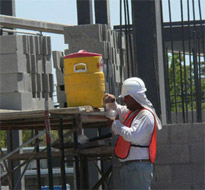
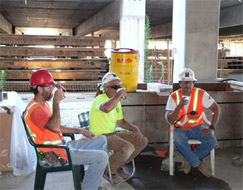
Provision of Drinking Water
Employers must provide drinking water at no cost to all employees. Water must be fresh, pure and suitably cool, and must be available at locations as close as possible to the areas where employees are working. To ensure that water is fresh, pure, and suitably cool, Cal/OSHA advises employers or supervisors to taste the water or pour some on their skin.
Fresh and Pure
Water must be fit to drink, or potable, and free from odors that would discourage workers from drinking the water. If an employer supplies individual water containers, the containers must be clean and a source of potable water (e.g., a municipal water source) must be readily available. Water from non-approved or non-tested water sources (e.g., untested wells) is not acceptable. If hoses or connections are used, they must be governmentally approved for potable drinking water systems, as shown on the manufacturer's label.
Suitably Cool
During hot weather, the water must be cooler than the ambient temperature but not so cool as to cause discomfort.
Where to Place Water for Employees to Drink?
Water must be placed as close as practicable to where employees are working. Placing water only in designated shade areas or where toilet facilities are located may not be sufficient.
Best Practices
Consider all available possibilities while deciding where to place water. For example, although it may be impossible or prohibited by law to place water stations within rows of crops where employees are working, it may be possible to place the water stations at the end of rows.
Water containers are smaller than shade structures. You can place them closer to employees than shade.
Where employees are working across large areas, place water in multiple locations. For example, on a multi-story construction site, place water in a safely accessible location on every floor where employees are working.
How Much Water Should Individuals Drink?
The recommendation is that during warm or hot weather employees drink four 8-ounce glasses of water, or a total of one quart per hour, throughout the entire work shift. Easy access to sufficient potable drinking water throughout the work shift encourages employees to drink.
Best Practices
Frequent drinking of small quantities of water is key to preventing heat illness:
- Encourage employees to avoid drinking alcohol altogether
- Encourage employees to choose water over other drinks (e.g., sodas and drinks containing caffeine and sugar) because these other drinks may increase dehydration. Also, if employees choose these other drinks they may drink less water.
Best Practices
How to Provide a Sufficient Water Supply and Encourage Consumption
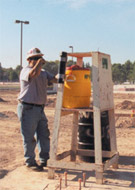
- It is vital that supplies of potable water be reliable. This means that effective procedures for replenishment of water supplies are in place so:
- Employees can count on a sufficient supply of water throughout the entire work shift and they do not feel pressured to drink less water to conserve the supply
- Water containers are never empty
- Water containers are filled before employees need to report that the water should be replenished
- Train supervisors and employees on the importance of consuming sufficient amounts of water to help prevent heat illness
- Remind supervisors and coworkers to:
- continue drinking sufficient amounts of water before and after work to reduce the risk of heat illness for the following work day
- Address potential obstacles that may prevent or discourage drinking sufficient water by taking the following actions:
- Place water near employees’ work, gathering, and break areas to help ensure that it is easy for them to reach the water supply. This will also help minimize disruptions of workflow and production

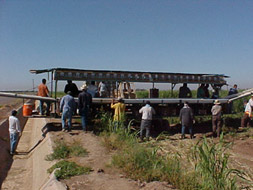
- Provide clean, portable water containers (see T8 CCR Sections
1524,
3363,
3457) and keep buttons, levers, or spouts where the water comes out clean throughout the shift.
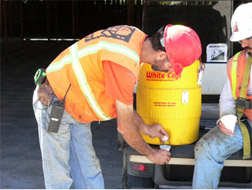
- Provide single use drinking cups (see T8 CCR Sections
1524,
3457)
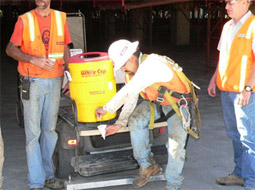
- Inform all employees they will not be penalized for frequently drinking sufficient amounts of water.
- Provide easily accessible sanitation facilities (see T8 CCR Sections 1526, 1527, 3457, 3364, 3366).
- Inform all employees, including those working under “piece rate” pay, that it is to their benefit to drink enough water. They will be healthier and able to maintain their work pace throughout the entire shift.
- Place water near employees’ work, gathering, and break areas to help ensure that it is easy for them to reach the water supply. This will also help minimize disruptions of workflow and production
- Arrange for vehicles or equipment to continually move the water to areas near where employees are working so they have quick, easy access (e.g., at the end of rows of crops or fruit trees, near construction site activities, near road work). Use:
- Pick-up trucks

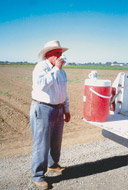
- A dedicated tractor, forklift or other piece of equipment
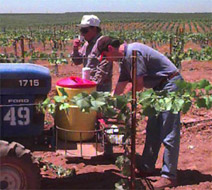
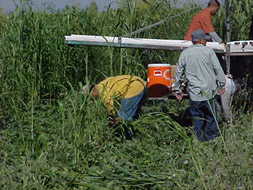
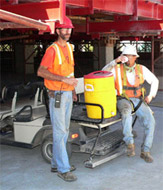
- Trailers
- Gondolas
- Harvest machines
- Pick-up trucks
- Have a designated person(s) whose duties include distributing and replenishing water. If it is necessary to distribute and replenish water over a large area, more than one person should be designated to perform this function. This person or persons should also encourage employees to drink small quantities of water frequently.


